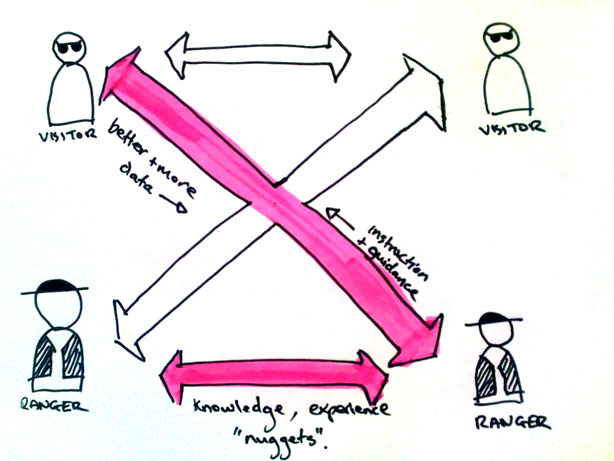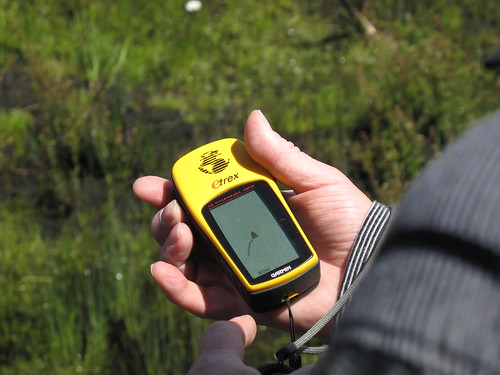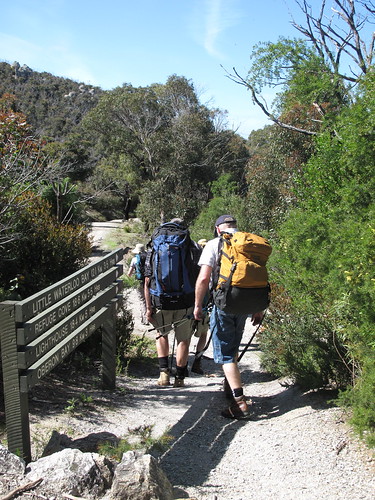Knowledge pathways

A diagram showing the connections between people in a national park, and highlighting some of the knowledge that passes between them
I’ve spent the last few days making sense of the discussions and observations made during the Affective Atlas team’s visit to Wilson’s Prom. Discussions centered firmly around the acquisition and dissemination of knowledge and how collaborative and social technologies can help connect various people in and around a national park. Whilst simplistic, the diagram above is a representation of the connections between the two main groups: Parks Victoria staff, and park visitors.
(Apologies for the poor drawing skills, I’m attempting to emulate some of Jeremy Yuille’s diagrams. Suggestions on how to draw a better park ranger are welcome.)
Each arrow represents a possible area of focus for our research. Whilst all the connections in the diagram are worth exploring, the most topical are those highlighted in pink: What rangers can tell each other, and what visitors can tell rangers. Summaries and ideas for these two major relationships are discussed below (very briefly!)
Visitors and Rangers
A lot of the focus to date has been on the types of information and knowledge the organisation can receive from Park Visitors. Suggestions have ranged broadly, and fall into both quantitative and qualitative categories.
Quantitatively, the potential for crowd-sourcing raw data collection has been a focus. The potential for leveraging geotagged photos stored in flickr was a common example, however a more grass-roots community approach has also been discussed, e.g. Creating a formal structure for the many amateur/hobbyist botany groups to contribute their research in ways useful for Parks Victoria scientists.
Qualitatively, the ability to capture stories and intangible moments people experience in the park was seen as important in communicating the community and social importance for responsible parks management. Allowing people to contribute and explore these stories will in turn foster a greater attachment to the park, and possibly allow a more rich form of communication between the visitors themselves.
Justified decision making was an example offered for communication in the opposite direction – Parks Victoria exposing decisions about controlled burns in a way that engages community groups.
This in itself is a very juicy and worthwhile problem. However, not much else was discussed in terms of what could be provided back to park visitors. In some respects this already happens in more conventional ways, through the Parks Victoria website and the on-site information centres. It would be worth exploring the potential for some sort of push or pull service aimed at providing information to parks visitors on site, in the context in which they need it.

What data/knowledge could Parks Victoria ask park visitors to collect or volunteer? What would be useful, and what would be the motivation for people to get involved?
Rangers and Rangers
One thing the meetings did for me was highlight the importance of the relationship between rangers, both at an organisation level and particularly at a park level. We spoke to Jim Whelan about this topic after he presented his Knowledge Map vision, and gained valuable insights into the very large problem of park specific knowledge dissapearing when staff move on.
Jim spoke about how, due to budget and time constraints, new staff simply don’t have the chance to spend time with more experienced rangers, and that the knowledge these “veterans” have is simply being lost through a natural attrition of retirements and transfers.
Jim’s vision for the knowledge map was one of connecting people – knowing what people are doing in other parks, knowing who the experts in a particular area are, and the sharing of tacit knowledge.
Jim’s term for this knowledge was “nuggets” – referring to the pieces of knowledge that rangers gain only from other rangers, or from their own hard-earned experience. Whilst there are many rangers with years of experience managing parks in general, much value comes from knowing a particular park intimately. Currently, this value is lost on an increasingly regular basis.
This particular problem has really sparked my curiosity, as it has elements of group psychology, community and social knowledge and service/system design. A service designed to capture and disseminate tacit knowledge in an effective manner could be a very large (and exciting) challenge.
A bit of clarity
I now have a much clearer understanding of the problems at hand, and potential areas that I can investigate. I plan on continuing my reading on knowledge, and particularly how knowledge is passed between people and in groups.
Some questions:
– “Parks Rangers” and “Park Visitors” are very broad groups – what different types of people are there, and who else is involved?
– What are the potentials for the other knowledge pathways? Particularly the visitor <-> visitor path.
Would love to hear your thoughts!
One Response to Knowledge pathways
Leave a Reply Cancel reply
Search
Geoplaced
This is a notebook exploring the gaps between geography, sociology, technology, science fiction and things between.
I used to write about my PhD here, which I finished in July 2013. You can download a PDF or order a print-on-demand copy of my PhD thesis.
Themes
- art (1)
- Augmented Reality (2)
- Brain Dump (17)
- Conducting a PhD (13)
- Context (6)
- essay-a-fortnight (2)
- fiction (1)
- Government (1)
- How to: Get a PhD (5)
- inspiration (4)
- Knowledge (15)
- Location (19)
- Methods (6)
- Mobile (2)
- Parks Vic (17)
- Place/Space (5)
- Research Questions (11)
- Technology (3)
- travel (1)
- ubicomp (7)
- Uncategorized (11)
- Visualisation (10)




Good reading.
Suggest an opportunity exists to give people a notepad as they walk through the parks and to note down times where a device would be useful. For example, a question, a need a point of interest.
Also be interesting to see how the veteran knowledge could be captured and used for park visitors.
Challenge is to find the valuable core and build/design from that before jumping too quickly into features.